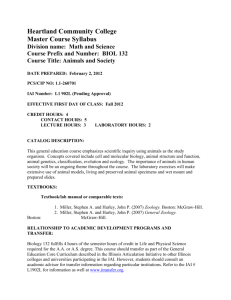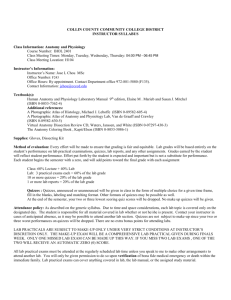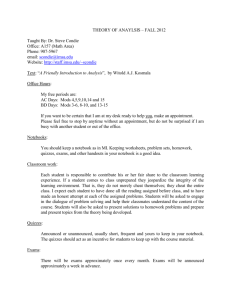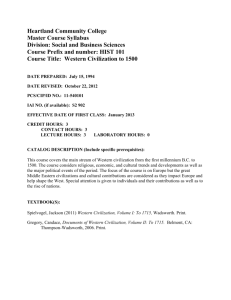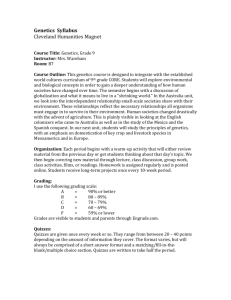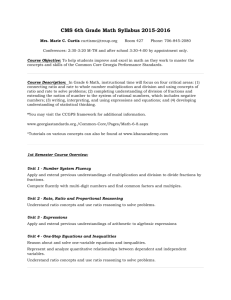BIOL131_Apr2014 - Heartland Community College
advertisement
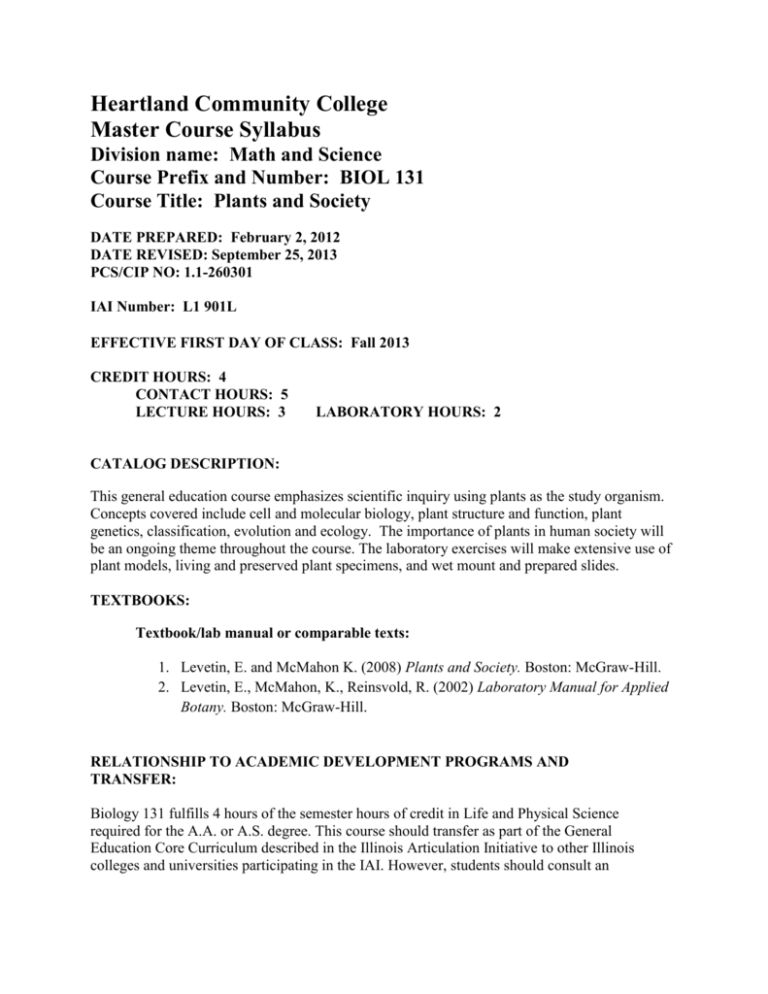
Heartland Community College Master Course Syllabus Division name: Math and Science Course Prefix and Number: BIOL 131 Course Title: Plants and Society DATE PREPARED: February 2, 2012 DATE REVISED: September 25, 2013 PCS/CIP NO: 1.1-260301 IAI Number: L1 901L EFFECTIVE FIRST DAY OF CLASS: Fall 2013 CREDIT HOURS: 4 CONTACT HOURS: 5 LECTURE HOURS: 3 LABORATORY HOURS: 2 CATALOG DESCRIPTION: This general education course emphasizes scientific inquiry using plants as the study organism. Concepts covered include cell and molecular biology, plant structure and function, plant genetics, classification, evolution and ecology. The importance of plants in human society will be an ongoing theme throughout the course. The laboratory exercises will make extensive use of plant models, living and preserved plant specimens, and wet mount and prepared slides. TEXTBOOKS: Textbook/lab manual or comparable texts: 1. Levetin, E. and McMahon K. (2008) Plants and Society. Boston: McGraw-Hill. 2. Levetin, E., McMahon, K., Reinsvold, R. (2002) Laboratory Manual for Applied Botany. Boston: McGraw-Hill. RELATIONSHIP TO ACADEMIC DEVELOPMENT PROGRAMS AND TRANSFER: Biology 131 fulfills 4 hours of the semester hours of credit in Life and Physical Science required for the A.A. or A.S. degree. This course should transfer as part of the General Education Core Curriculum described in the Illinois Articulation Initiative to other Illinois colleges and universities participating in the IAI. However, students should consult an academic advisor for transfer information regarding particular institutions. Refer to the IAI # L1901L for information as well at www.itransfer.org. COURSE OBJECTIVES (Learning Outcomes): At the completion of this course, student will be able to: Course Outcomes Describe the process of scientific method used in plant research. Describe the basic structure and function of plants. General Education Outcomes CT1 CO2 Range of Assessment Methods Exams, Experiments, Lab Reports, Quizzes, Lab Dissection Simulations, Concept Maps, Group Projects, Individual Projects, Journal Article Reports, Short papers and Case Studies Exams, Experiments, Lab Reports, Quizzes, Lab Dissection Simulations, Concept Maps, Group Projects, Individual Projects, Journal Article Reports, Short papers and Case Studies Identify the plants at the family and genus level. Exams, Experiments, Lab Reports, Quizzes, Lab Dissection Simulations, Concept Maps, Group Projects, Individual Projects, Journal Article Reports, Short papers and Case Studies Analyze the Mendelian principles of Genetics Exams, Experiments, Lab Reports, Quizzes, Lab Dissection Simulations, Concept Maps, Group Projects, Individual Projects, Journal Article Reports, Short papers and Case Studies Examine the effects of plants on human society. Exams, Experiments, Lab Reports, Quizzes, Lab Dissection Simulations, Concept Maps, Group Projects, Individual Projects, Journal Article Reports, Short papers and Case Studies Analyze various factors effecting the environment. Describe the evolutionary relationship among the major groups of plants CT1 Exams, Experiments, Lab Reports, Quizzes, Lab Dissection Simulations, Concept Maps, Group Projects, Individual Projects, Journal Article Reports, Short papers and Case Studies Exams, Experiments, Lab Reports, Quizzes, Lab Dissection Simulations, Concept Maps, Group Projects, Individual Projects, Journal Article Reports, Short papers and Case Studies CO2 – Students effectively deliver a message via various channels/modalities. CT1 – Students gather knowledge, apply it to a new situation, and draw reasonable conclusions in ways that demonstrate comprehension. COURSE OUTLINE: Unit1. Introduction to Scientific methods, Chemistry and Plant cell structure What is science? What is the scientific method? Basic chemistry and organic macromolecules Biological and chemical components of plants and their importance to society Basic unit of life- the structure of prokaryotic and eukaryotic cells Detailed function of cell organelles Unit 2 Molecular genetics, Cell cycle and Plant Genetics DNA replication Gene expression and Protein Synthesis Plant cloning, genetically modified organisms and their impact on society Cell cycle Asexual and sexual lifecycle of plants Flowers and Seeds Mendelian laws of genetics Unit 3 Plant Structure & Physiology Plant organization Basic anatomy and function of root and human use Basic anatomy and function of stem and human use Basic anatomy and function of leaf and human use Process of photosynthesis and respiration Impact of plant metabolic processes Unit 4 Plant Diversity, Evolution and Ecology Classification basics Evolution of plant groups Characteristics and human uses of algae Characteristics and human uses of fungi Characteristics and human uses of seedless plants Characteristics and human uses of gymnosperms Characteristics and human uses of Angiosperms Biomes and ecosystem Green house effect and global warming LAB OUTLINE: Scientific method (Supplemental Lab) Microscopy Chemical components of the cell The cell ` Movement of water into the cell Metabolic reactions photosynthesis and respiration Cell division processes (mitosis and meiosis) Plant genetics Morphology and anatomy of root, stem, flower and leaves Classification of plants METHOD OF EVALUATION (Tests/Exams, Grading System): Student grades will be based on multiple measures of student performance which may include the following: exams, experiments, lab reports, journal article reports, short papers, quizzes, lab dissection simulations, concept maps, group projects, individual projects and case studies. The grading scale for the course is as follows: 90-100% 80-89% 70-79% 60-69% 0-60% A B C D F Lecture activities account for 75% of the final grade; lab activities account for 25% of the final grade. REQUIRED WRITING AND READING: Students are required to read the assigned textbook chapters, lab manual readings as well as other readings that may be assigned, approximately 30 to 50 pages per week. Some research based writing will be required, including but not limited to summaries of articles, projects or portfolios, worksheets and lab exercises.
